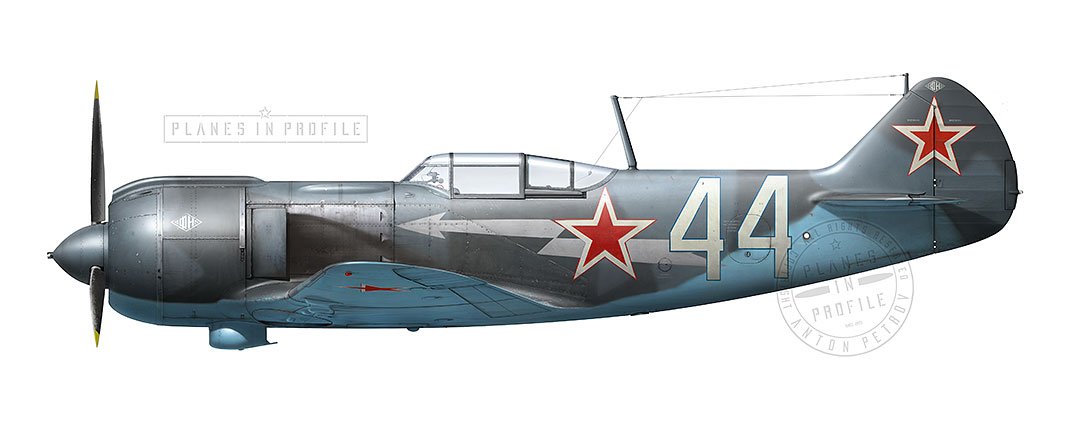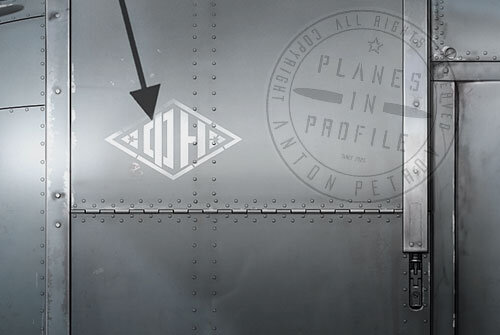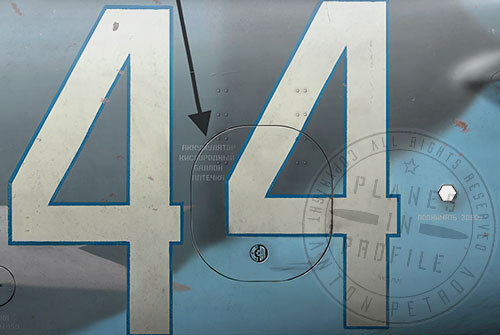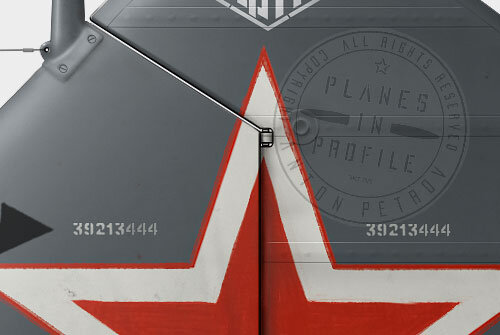Trefilov’s White-44
Lavochkin, La-5FN (Late)
2nd Squadron, 523 IAP of 303 IAD, 3-rd Belorussian Front, Lithuania, circa late 1944.
Flown by Anatoliy Panteleevich Trefilov.
From June 1944, by order of the commander of the air army T. T. Hryukin, 523rd regiment switched primarily to aerial reconnaissance and thus became the reconnaissance regiment of the entire 3rd Belorussian Front [1] ( It remained in that role until the end of the war). To help fulfil this role, the regiment received brand new La-5FN planes and aero-photocameras of the ‘AFA-I’ and ‘AFA-B’ type. The cameras were then fitted inside the planes’ fuselages (this was done on the airfield), with the ‘camera viewing’ openings cut out at the bottom so that the cameras can photograph the ground below.
In November 1944 Trefilov joined this regiment too, having been transferred there from the 139-th GIAP. This is presumably when he started to fly his new ‘44’ plane. The photo of ‘Trefilov’s-44’ readying to take off on a mission, with the technician by the surname Burlachek pointing the way, is presumed to have been taken at around that time, though judging by what appears to be external ‘wear and tear’ on the airplane it’s possible that the photo was taken later.
An interesting point to note is that the reconnaissance pilots of 523 IAP, including Trefilov, were generally not allowed to engage in air combat with enemy aircraft, unless it was absolutely necessary! According to the WW2 recollections of the regiment’s ‘senior aero-photo-equipment technician’ Ivan Emelievich Vislobokov :
“The Command of the first Air Army categorically forbade the regiment's reconnaissance pilots to engage in aerial combat with the enemy during reconnaissance flights without an urgent need, as this would threaten to disrupt the mission or to lose valuable information about the enemy obtained in a difficult operational situation. The pilots who deviated from their combat mission for a fleeting victory could not rely on the forgiveness of their commanders, even if while doing so they managed to shoot down not one, but two or three enemy aircraft. The pilots were rewarded not for the number of enemy planes they destroyed, but for the amount and the quality of vital intelligence they gathered “ [2]
And 523IAP gathered a lot of intelligence! It ended the war as a highly decorated regiment.
By 9th of May, 1945, Trefilov became a vice-commander of his squadron , by that time he had flown 312 battle missions (159 of those were reconnaissance sorties). During air battles he shot down one enemy fighter (A German FW-190). [3]
Noteworthy Visual Characteristics
1. The classic symbol representing the FN model of La-5, a rhombus with the Cyrillic letters ‘F’ and ‘N’ inside it. The same symbol appears on the tip of the tail. These letters have to do with the improved engine which was given a designation M-82FN (or ASh-82FN). The letter ‘F’ is derived from the word ‘Forsirovanniy’ which means forced/boosted and refers to an improved supercharger (Same as in the La-5F ’s engine), and the letter ‘N’ is derived from ‘Neposredstvenniy’ which refers to the direct fuel injection system (as opposed to the one that used a carburetor in the previous models).
This photo shows a very good close-up of what the logo/symbol looks like (This is not a photo of White-44 , but is just a good close-up shot of the logo/emblem). https://aviaforum.ams3.cdn.digitaloceanspaces.com/data/attachment-files/2020/02/1489950_8f38b1e8d0f9a9034b786c98474180ff.jpg
2. The large lightnings on the fuselage were the identification markings of the planes of 303 Fighter Division (IAD). Based on the photo reference it appears that White-44’s lightnings are not as dark as the star (so probably not red), but are darker than white (So probably not white). Initially I drew the lightning as yellow, but later I was advised by a Russian researcher Mikhail Bykov that they were not likely to be yellow for a number of reasons. The main reasons being: 1) Yellow was a high visibility colour, inappropriate to a reconnaissance airplane such as Trefilov’s White-44. 2) Yellow was a difficult colour to come by for the Soviets in WW2, so it didn’t appear often on the Soviet planes. Yellow, in general, was more common to German planes.
So in the end it was settled that the lightning is most likely a dark white (grey) or Silver. In my artwork I leaned more towards the ‘Silver arrow’, this is because in some photo reference it appears to be quite dark in some places and quite light in others, which could be explained by the reflective nature of the silver colour. A discussion (in Russian) about this occurred in the comments section of the ‘Planes In Profile’ Facebook page which can be found here.
3. It’s difficult to tell from the reference if there were any technical markings on Trefilov's-44 around the area of the hatch. The photo reference is quite poor and the markings aren't visible at all. http://ava.org.ru/iap/523/la5fn_44-trefilov.jpg . There is a chance that it might have been faintly painted or has rubbed off over time. But it was standard on most La-5FNs, so it was included in my artwork.
4. The serial number of Trefilov’s ‘White-44’ was 39213444. It appears on the tail and on the horizontal stabilisers. The close-up of the serial number (on the horizontal stabiliser) can be seen in this photo: http://ava.org.ru/iap/523/podmetin-trefilov-doroshenko.jpg . The photo also shows Trefilov , still wearing his pilot’s helmet after one of the reconnaissance missions.
5. The shape of the heat panel is that of the late type La-5FN.
6. AMT-7 blue is sprayed over the rudder, which is a slight deviation from the standard camouflage pattern introduced in 1943, but it is quite common.
7. On Patreon
8. The paint on the cowl bands appears to have partly chipped off, exposing bare metal .
9. On Patreon
10. On Patreon
11. The tips of the propeller blades were painted, most probably ‘yellow’ for high visibility, as can be seen in this photo http://ava.org.ru/iap/523/la5fn-1945.jpg
12. There appears to be a lighter shape on the camouflage under the star. It is visible in this close-up photo.
Here are a few closeup images to help illustrate the points above. Full set of close-up images is On Patreon
FOOTNOTES
[2] This is a passage which I translated from page 98 of the book ‘From Soldier to General’ http://window.edu.ru/catalog/pdf2txt/113/62113/32020?p_page=10 ).
All the work presented on this is page is subject to updates and revisions in the light of new information which might present itself. If you have any new information relevant to this page or disagree with anything that's presented here, then please feel free to contact me through the Planes in Profile Facebook page. Thanks:)
Special thanks to Władysław Arhipov, Mikhail Bykov and Aleksey Pekarsh for contributing their comments and a photo fragment of White-44 in a short Facebook discussion about this airplane.





